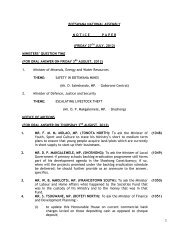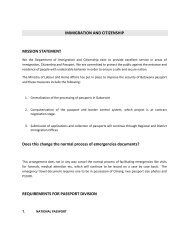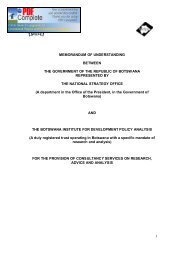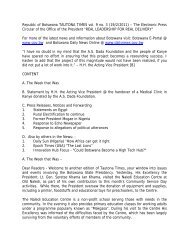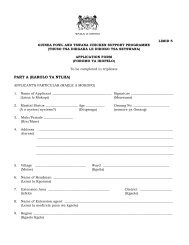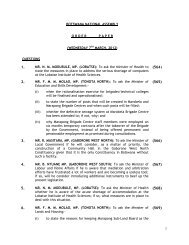Roads Department - Government of Botswana
Roads Department - Government of Botswana
Roads Department - Government of Botswana
Create successful ePaper yourself
Turn your PDF publications into a flip-book with our unique Google optimized e-Paper software.
<strong>Roads</strong> <strong>Department</strong><br />
2.6 Appearance and Identification<br />
Depending on the environment, salt levels and type <strong>of</strong> surfacing salt damage<br />
may occur within days after priming or up to 2 to 3 years after surfacing.<br />
Surfacing Type<br />
Bituminous cut back primes<br />
Bituminous emulsion prime<br />
Single surface dressing<br />
Slurry seal<br />
Cape seal<br />
Double surface dressing<br />
Otta Seal -Single with sand cover seal<br />
Otta Seal -Double<br />
Typical duration before first<br />
signs <strong>of</strong> damage<br />
1 day to 7 days<br />
2 days to 14 days<br />
7 days to 6 months<br />
5 days to 3 months<br />
14 days to 6 months<br />
3 months to 3 years<br />
3 months to 3 years<br />
12 months to 4 years<br />
2.6.1 Damage to Primes<br />
Bituminous prime coats are the most susceptible to salt damage because <strong>of</strong><br />
their thickness and high permeability to evaporation. Damage to prime coats<br />
typically occurs in the form <strong>of</strong> small blisters which, when opened, reveal white<br />
salt powders. This can <strong>of</strong>ten be mistaken for vapour blisters, which result from<br />
vapour pressure differentials following rainfall on a freshly primed road surface.<br />
Salt damage is <strong>of</strong>ten observed within days after<br />
priming or up to 2-3 days after surfacing.<br />
Tsabong - Makopong road.<br />
In other cases damage to primed surfaces occurs in the form <strong>of</strong> powdering<br />
<strong>of</strong> the surface such that it becomes completely loose and has a brown ‘dead’<br />
appearance instead <strong>of</strong> black. Damage typically starts at the edge <strong>of</strong> the road<br />
where evaporation occurs most or where there has been disturbance to the<br />
surface texture such as along the overlap <strong>of</strong> spray applications or along construction<br />
vehicle wheel tracks. The top <strong>of</strong> the underlying base layer may also<br />
appear loose. In many cases hair-like (whiskers) crystals can be observed with<br />
land lens and in severe cases <strong>of</strong> damage, with the naked eye. Initial signs <strong>of</strong><br />
damage to prime coats can be observed within 24 hours after surfacing.<br />
2.6.2 Damage to Permanent Surfacings<br />
Salt damage to more permanent surfacings such as double surface treatments<br />
and slurry seals may take several days to a few years to manifest at the surface.<br />
This will generally appear as star shaped domes that open at the top to reveal<br />
clusters <strong>of</strong> white salt powder. The domes can range from a few centimetres to<br />
20 cm in diameter with a typical height <strong>of</strong> 2 to 6 cm.<br />
2.7 Summary <strong>of</strong> Physico-chemical<br />
Influences on Salt Damage<br />
The main factors governing the mechanism <strong>of</strong> salt damage are salt solubility,<br />
migration, crystallisation, crystal growth habit and crystal pressures.<br />
Highly soluble salts can re-crystallise several<br />
times a day as temperature changes causing<br />
physical damage to road surfacings.<br />
Solubility<br />
Only those salts that are soluble in water can migrate to the surface <strong>of</strong> a pavement.<br />
The solubility <strong>of</strong> some natural salts is shown in Figure 2.4 in relation<br />
22 Chapter 2<br />
Guide to the Prevention and Repair <strong>of</strong> Salt Damage to <strong>Roads</strong> and Runways<br />
Occurrence and Characteristics



